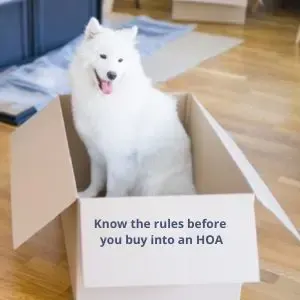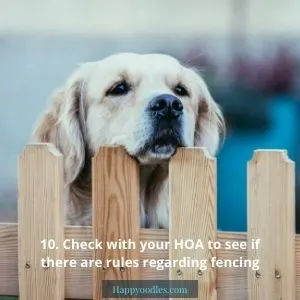When my mother-in-law decided that she wanted to move closer to us we were trilled.
But she didn’t want to live in a suburban area with a big lawn.
So, with this in mind we started to research nearby planned communities.
If you have ever lived in a planned community you know that they tend to have Homeowner Associations (HOA).
The point of a HOA is to ensure that the community is properly maintained and that everyone gets along.
To do this the HOA sets up rules that everyone who chooses to live there must follow.
Naturally, as a dog person, part of my research had to include learning all about Homeowner Association rules for dogs. In this post I will go over the 10 Common Homeowner Association rules for dogs that I found through my research.

Disclosure: The information provided in this post is based on my own experiences and research. It should not be viewed as legal advice.
Homeowner Associations
Before I talk about homeowner association rules for dogs, it’s important to understand what homeowner associations are:
Homeowner associations are commonly found in planned communities where homeowners share resources like a community pool or common grounds. The HOA is made up of property owners in the community. In newer communities the property owners may also include the developer. HOA board members are generally volunteers who are elected by the property owners for the purpose of running the HOA.
The HOA board members are responsible for taking care of all the areas that serve the general community. This includes but is not limited to the maintenance of the common areas, community utilities and buildings.
Most HOAs require that all property owners pay a monthly maintenance fee. In addition to the monthly fee, property owners may be required to pay special one-time assessments to cover large community expenses and some HOAs also require a one-time buy-in fee for all new homeowners.
The rules of an HOA and how they should be handled should be documented in the HOA’s bylaws, Association’s covenants, conditions, and restrictions (CC&R) and a rules and regulation documents. It is in these documents that you should be able to find the homeowner association rules for dogs and how they are enforced.
Homeowner association terms you need to know
There is a lot of information on HOA’s on the web and I strongly recommend that you do your own research on HOAs and the rules governing them in your home state. To help, I have listed a number of resources I found at the end of this post. Here is a quick overview of my understanding of the three documents that make up the rules of a HOA.
Association’s covenants, conditions, and restrictions (CC&R)
CC&Rs is a legal document that spells out the rules and property limitations of the planned community they are associated with. If you buy into a planned community with a CC&R you must agree to live by these rules in order to reside in the community. It’s important that you understand all the conditions in the CC&R before you buy a home. When you close on your home you will be bound by them.
HOA’s bylaws
While the CC&R lists the rules of the community, the bylaws govern how the HOA will be run. In the bylaws you will find things like:
- How often the HOA board meetings are held
- Process for nominating and electing new board members
- Number of members that serve at one time
- Length of board member service terms
- Duties and responsibilities of board members
- How the rules will be enforced
Rules & Regulations
The rules and regulation is a supplement to the DD&R and the bylaws. This document tends to cover everything that was not included in the other two documents. This is also the place where they list rules that might change based on the community needs.
Who runs the homeowners associations?
The common belief is that homeowner associations are run by volunteers who live in the community. While that might be true for older communities, in newer communities the HOA may be controlled by the developer. Although the rules differ by state, some states allow the developer to stay in control of the HOA until the majority of the homes are sold.
Also HOA’s can choose to outsource the management of the community to an HOA Management Company. To what extent that HOA Management Company runs the HOA depends on the contract with the HOA. Often the management company takes on the maintenance of the property and also enforcing the rules of the HOA.
Why do Homeowner Associations have pet rules?
The purpose of a homeowner’s association is twofold; the first is to maintain the property and keep it looking nice. The second is to keep the peace. When there are rules in place, which everyone knows ahead of time, it’s easier for people to know what to expect. Therefore as long as everyone follows the rules, in theory at least, there should be little conflict between neighbors.

10 Common Homeowner Association Rules for Dogs
Although HOAs can legally choose to prohibit all pets from a community development there aren’t many that do. The ones that do tend to be condominium complexes or communities that are very close together. Most HOAs will handle potential problems with pets through the HOA pet rules.
1. Limit the number of pets allowed
The first rule on our list is pretty common to see. In this one the HOA may have a limit on the total number of pets you can have while living in the community. This limit can include all types of pets; dogs, cats, fish, hamsters, etc. If this is the case at the community you are planning to live in, make sure you are ok with this rule now and in the future.
Another thing to think about is whether you may want to breed your dog, since a litter of puppies may cause you to go over the pet limit.
2. Require that all pets are registered with the HOA
The second rule is to require pet owners to register all their pets with the HOA. By knowing what pets and how many live in each resident it makes it easier for the HOA to follow up with people who violate the pet rules.
3. Must show proof of rabies vaccines
In addition to registering your pets you may be required to show proof of vaccines for your pets. For dogs it is common for places to want to see proof of their rabies vaccines.

4. HOA’s may have a maximum size limit for dogs
Although size does not indicate whether a dog will be destructive or aggressive, it is one of the ways HOA’s can limit possible damage. So if you have a puppy right now make sure you have a good idea of what size they will be when they grow up if your HOA has a maximum size limit.
5. Not allow certain dog breeds
In addition to a limiting the size of the dog, some HOA do not allow what they consider to be aggressive dog breeds in the community.
6. Homeowners have to pick up after their pets
Ok this one should be done no matter where you live. Dog poop contains toxins and can be hazardous to other dogs and people who use the common areas. But in a HOA you may be fined if you don’t clean up after their pets.
If your new home includes a backyard, you will want to check out our post on Dog Potty Area tips.
7. Leash requirements
It is common for a HOA to require that dogs must be leashed when they are on community property. The exception to this is if the community has an off leash pet area.
During my research I came across one community that took this one step further dictating where the dog could be walked in the community. Of course I was a bit surprised that they actually had to spell out that you shouldn’t let your dog poop next to your neighbor’s front door.
8. Where you can keep your pet outside at home
Some places will restrict you from keeping your dog outside either on your deck, patios porch or even your yard.
What to make your patio dog friendly, check out our post on Dog Patio Ideas – For Small Spaces
9. HOA Dog Barking Rules
If you have a dog that wants to protect their home by barking at every stranger that goes by, you may not be a good candidate for a HOA with dog barking rules.

10. Rules regarding fences
So this is one you might not be thinking of when you review the CC&R, but some HOA’s may restrict whether you are allowed to put up a fence around your yard.
In addition, if they do allow fences they may restrict the height of the fence or even the type of fence you are allowed to put up.
Final thoughts on Homeowner Association rules for dogs
In the end it is your responsibility to know what you are agreeing to before you buy your home. If you think there is any chance that you will not be able to live with the pet rules of the HOA you should not buy into one.
Remember, the reason why Homeowner Associations have rules for dogs and other pets is so that everyone can enjoy living there. Just because you think your dog is the greatest doesn’t mean the next person does.
Once you are in your new home you may want to create a room dedicated to your dog. If so, you should check out our newest posts from Dogs at Home- Dog Room Ideas – The newest Trend in Dog Care and Best Dog Wash Station Ideas for Home – 75+ Photos

